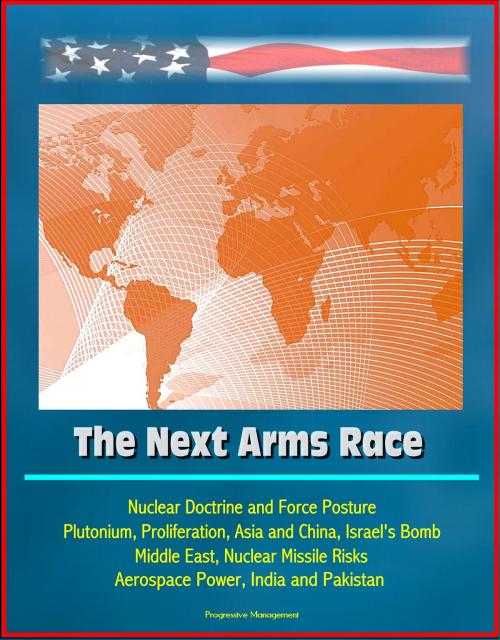The Next Arms Race: Nuclear Doctrine and Force Posture, Plutonium, Proliferation, Asia and China, Israel's Bomb, Middle East, Nuclear Missile Risks, Aerospace Power, India and Pakistan
Nonfiction, History, Military, Nuclear Warfare| Author: | Progressive Management | ISBN: | 9781301855100 |
| Publisher: | Progressive Management | Publication: | March 4, 2013 |
| Imprint: | Smashwords Edition | Language: | English |
| Author: | Progressive Management |
| ISBN: | 9781301855100 |
| Publisher: | Progressive Management |
| Publication: | March 4, 2013 |
| Imprint: | Smashwords Edition |
| Language: | English |
This 2012 report showcases studies that were done over the past three years on what the next set of strategic nuclear competitions might look like.
With most of the world's advanced economies now stuck in recession; Western support for defense cuts and nuclear disarmament increasing; and a major emerging Asian power at odds with its neighbors and the United States; it is tempting to think our times are about to rhyme with a decade of similar woes — the disorderly 1930s.
Might we again be drifting toward some new form of mortal national combat? Or, will our future more likely ape the near-half-century that defined the Cold War—a period in which tensions between competing states ebbed and flowed but peace mostly prevailed by dint of nuclear mutual fear and loathing?
The short answer is, nobody knows. This much, however, is clear: The strategic military competitions of the next two decades will be unlike any the world has yet seen. Assuming U.S., Chinese, Russian, Israeli, Indian, French, British, and Pakistani strategic forces continue to be modernized and America and Russia continue to reduce their strategic nuclear deployments, the next arms race will be run by a much larger number of contestants — with highly destructive strategic capabilities far more closely matched and capable of being quickly enlarged than in any other previous period in history.
- Overview * PART I: ASIA * 2. Asian Drivers of Russia's Nuclear Force Posture * 3. China's Strategic Forces in the 21st Century: The People's Liberation Army's Changing Nuclear Doctrine and Force Posture * 4. Plutonium, Proliferation and Radioactive-waste Politics in East Asia * 5. China and the Emerging Strategic Competition in Aerospace Power * PART II: MIDDLE EAST * 6. The Middle East's Nuclear Future * 7. Alternative Proliferation Futures for North Africa * 8. Casting a Blind Eye: Kissinger and Nixon Finesse Israel's Bomb * PART III: SOUTH ASIA * 9. Nuclear Weapons Stability or Anarchy in the 21st Century: China, India, and Pakistan * 10. Nuclear Missile-Related Risks in South Asia * 11. Prospects for Indian and Pakistani Arms Control * PART IV: POST-COLD WAR MILITARY SCIENCE AND ARMS CONTROL * 12. To What Extent Can Precision Conventional Technologies Substitute for Nuclear Weapons? * 13. Missiles for Peace * 14. Missile Defense and Arms Control * 15. A Hardheaded Guide to Nuclear Controls
This 2012 report showcases studies that were done over the past three years on what the next set of strategic nuclear competitions might look like.
With most of the world's advanced economies now stuck in recession; Western support for defense cuts and nuclear disarmament increasing; and a major emerging Asian power at odds with its neighbors and the United States; it is tempting to think our times are about to rhyme with a decade of similar woes — the disorderly 1930s.
Might we again be drifting toward some new form of mortal national combat? Or, will our future more likely ape the near-half-century that defined the Cold War—a period in which tensions between competing states ebbed and flowed but peace mostly prevailed by dint of nuclear mutual fear and loathing?
The short answer is, nobody knows. This much, however, is clear: The strategic military competitions of the next two decades will be unlike any the world has yet seen. Assuming U.S., Chinese, Russian, Israeli, Indian, French, British, and Pakistani strategic forces continue to be modernized and America and Russia continue to reduce their strategic nuclear deployments, the next arms race will be run by a much larger number of contestants — with highly destructive strategic capabilities far more closely matched and capable of being quickly enlarged than in any other previous period in history.
- Overview * PART I: ASIA * 2. Asian Drivers of Russia's Nuclear Force Posture * 3. China's Strategic Forces in the 21st Century: The People's Liberation Army's Changing Nuclear Doctrine and Force Posture * 4. Plutonium, Proliferation and Radioactive-waste Politics in East Asia * 5. China and the Emerging Strategic Competition in Aerospace Power * PART II: MIDDLE EAST * 6. The Middle East's Nuclear Future * 7. Alternative Proliferation Futures for North Africa * 8. Casting a Blind Eye: Kissinger and Nixon Finesse Israel's Bomb * PART III: SOUTH ASIA * 9. Nuclear Weapons Stability or Anarchy in the 21st Century: China, India, and Pakistan * 10. Nuclear Missile-Related Risks in South Asia * 11. Prospects for Indian and Pakistani Arms Control * PART IV: POST-COLD WAR MILITARY SCIENCE AND ARMS CONTROL * 12. To What Extent Can Precision Conventional Technologies Substitute for Nuclear Weapons? * 13. Missiles for Peace * 14. Missile Defense and Arms Control * 15. A Hardheaded Guide to Nuclear Controls















